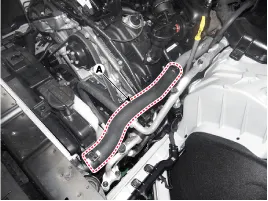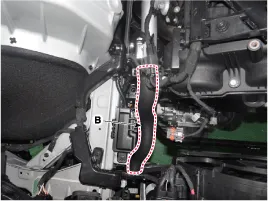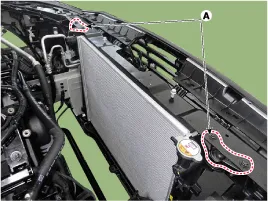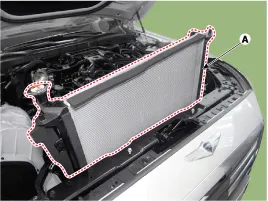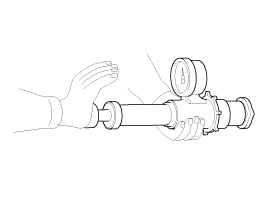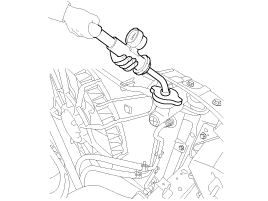Hyundai Genesis (DH): Cooling System / Radiator Repair procedures
Hyundai Genesis (DH) 2013-2016 Service Manual / Engine Mechanical System / Cooling System / Radiator Repair procedures
| Removal and Installation |
| 1. |
Disconnect the battery "-" terminal from the trunk room. |
| 2. |
Loosen the drain plug and drain the engine coolant.
(Refer to Cooling System - "Coolant") |
| 3. |
Remove the cooling fan.
(Refer to Cooling System - "Cooling fan") |
| 4. |
Disconnect the radiator upper hose (A) and lower hose (B).
|
| 5. |
Remove the radiator upper mounting bracket.
|
| 6. |
Remove the fixing bolts (A) between the radiator assembly and
the A/C condenser, and then remove the radiator (A) from the vehicle.
|
| 7. |
To install, reverse the removal procedure.
Fill the radiator with coolant and check for leaks. |
| Inspection |
Radiator Cap Testing
| 1. |
Remove the radiator cap, apply engine coolant to the seal, and then install a pressure tester on it.
|
| 2. |
Apply a pressure of 93.16 ~ 122.58 kPa (0.95 ~ 1.25 kg/cm?, 13.51 ~ 17.78 psi). |
| 3. |
Check the pressure for any changes. |
| 4. |
If the pressure drops, replace the cap. |
Radiator Leakage Test
| 1. |
Wait for the engine to cool down, then carefully remove the
radiator cap and fill the radiator with engine coolant, then install the
pressure tester.
|
| 2. |
Apply a pressure tester to the radiator and apply a pressure of 93.16~122.58 kPa (0.95~1.25 kg/cm?, 13.51~17.78 psi). |
| 3. |
Inspect for engine coolant leaks and a drop in pressure. |
| 4. |
Remove the tester and reinstall the radiator cap.
|
Components 1. Radiator assembly2. Radiator upper mounting bracket3. Radiator lower mounting insulator4. Radiator cap5. Radiator lower hose6. Radiator upper hose7.
Removal and Installation 1. Disconnect the battery "-" terminal from the trunk room. 2. Remove the engine cover. 3. Remove the engine room cover.
Other information:
Hyundai Genesis (DH) 2013-2016 Service Manual: Specifications
S
Hyundai Genesis (DH) 2013-2016 Service Manual: Head Up Display Unit Repair procedures
Removal 1. Disconnect the negative (-) battery terminal. 2. Remove the head up display bezel (A). 3. Remove the instrument cluster. (Refer to Indicators And Guages - "Instrument Cluster") 4. Remove the head up display unit bracket (A) after loosening the mounting nuts.
Categories
- Manuals Home
- Hyundai Genesis Owners Manual
- Hyundai Genesis Service Manual
- Rain Sensor Repair procedures
- ECS-G Sensor Repair procedures
- Suspension System
- New on site
- Most important about car
Copyright В© 2026 www.hgenesisdh.com - 0.0237

